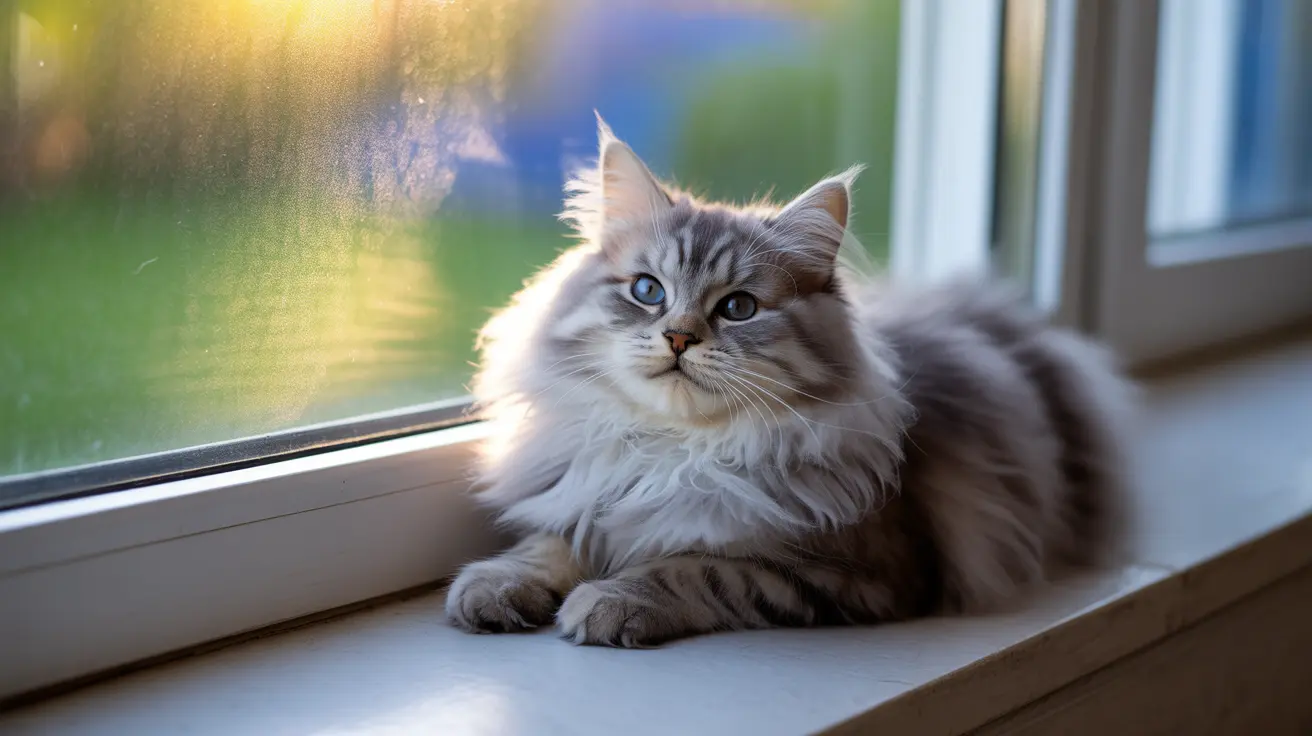Cat-Specific Music for Stress Relief: A Science-Based Guide to Calming Your Feline Friend
When your cat displays signs of anxiety—whether from a veterinary visit, environmental changes, or loud noises—you might wonder if there's a natural way to help them feel more at ease. Recent scientific research has revealed a fascinating solution: cat-specific music for stress relief. Unlike traditional music designed for human ears, these specially composed soundscapes incorporate feline vocalizations and frequencies that resonate with your cat's natural communication patterns.
Studies conducted at veterinary clinics and research facilities have demonstrated that music specifically created for cats can significantly reduce stress behaviors and improve handling during examinations. This breakthrough in feline welfare represents a shift from generic classical music to scientifically-designed audio therapy that addresses cats' unique auditory sensitivities. Understanding how this specialized music works and how to implement it effectively can transform stressful situations for both you and your feline companion.
This comprehensive guide explores the science behind cat-specific music, practical applications for home and veterinary settings, and evidence-based strategies for incorporating sound therapy into your cat's stress management routine.
The Science Behind Cat-Specific Music and Feline Stress Response
Cat-specific music differs fundamentally from human music in both composition and frequency range. Research shows that effective feline music incorporates melodic cat sounds such as purring and suckling, combined with musical tones approximately two octaves higher than typical human voice frequencies. This design matches the natural vocal ranges that cats use for communication, creating familiar auditory environments that promote relaxation.
Multiple clinical studies have evaluated the effectiveness of cat-specific music compared to classical music and silence. In a randomized, placebo-controlled crossover trial involving 20 healthy cats, researchers found that cat-specific music significantly lowered Cat Stress Scores (CSS) and handling scores during physical examinations. The cats exhibited fewer stress behaviors and demonstrated more relaxed body language when exposed to these specialized soundscapes.
The physiological mechanisms behind this response relate to how cats process different sound frequencies. Unlike humans, cats have evolved to be particularly sensitive to higher frequency ranges, which they use for hunting and communication. Music that incorporates these frequencies, along with familiar sounds like purring, can mask sudden artificial noises and create a sense of security in unfamiliar environments.
Clinical Evidence: Veterinary Studies and Measurable Results
Louisiana State University researchers conducted one of the most comprehensive studies on feline music therapy, testing cats during veterinary visits spaced two weeks apart. Each cat was exposed to three different conditions: cat-specific music, classical music, and no music. The results consistently showed that cats listening to cat-specific music displayed significantly fewer stress indicators during examinations.
A separate study involving 35 hospitalized cats revealed additional insights into music therapy effectiveness. Cats in the cat-specific music group showed a higher percentage of positive social interactions during the first evaluation compared to other groups. This finding suggests that the music not only reduces stress but may also improve cats' willingness to engage with veterinary staff, facilitating better care.
Interestingly, classical music also showed some benefits, particularly in reducing respiratory rates during certain evaluation periods. However, the effects were less consistent and pronounced compared to cat-specific compositions. These findings indicate that while any calming music may provide some benefit, music designed specifically for feline auditory preferences produces more reliable stress reduction.
Physiological Measurements and Study Limitations
While behavioral observations clearly demonstrated stress reduction, physiological measurements presented mixed results. Blood tests measuring white blood cell ratios, specifically neutrophil to lymphocyte ratios, did not show significant changes across different music conditions. Researchers suggest this may be because the 20-minute exposure periods were too brief to produce measurable biological changes in stress markers.
Salivary cortisol analysis, another potential stress indicator, proved challenging in hospitalized cats due to low saliva production under stress and sample contamination issues. These limitations highlight the importance of behavioral assessments over purely physiological measures when evaluating acute stress responses in clinical settings.
Creating Effective Cat Music Playlists for Home Use
Based on research findings, effective cat-specific music should incorporate several key elements. The most successful compositions include purring sounds, suckling noises, and frequencies that match feline vocal ranges. These elements should be integrated at volumes around 60-80 decibels—loud enough to mask environmental noise but not so loud as to cause additional stress.
When selecting music for your cat, look for compositions specifically designed for felines rather than generic relaxation music. Several streaming platforms, including Spotify, now offer playlists created based on scientific research into feline auditory preferences. These playlists typically feature longer tracks to maintain consistent auditory environments without jarring transitions.
For home use, consider playing cat-specific music during potentially stressful situations such as thunderstorms, fireworks, or when introducing new furniture or visitors. The music should be introduced gradually, allowing your cat to become accustomed to the sounds during calm periods before using it during stressful events.
Best Practices for Implementing Music Therapy with Cats
Successful implementation of cat-specific music therapy requires attention to timing, volume, and environmental context. Research suggests playing music during periods of greatest activity or stress, typically maintaining volumes at approximately 60 decibels to provide effective masking of environmental stressors without overwhelming feline hearing.
Duration of exposure appears important for effectiveness. While short 20-minute sessions showed behavioral benefits in veterinary studies, longer exposure periods may be necessary for sustained physiological changes. For home use, consider playing music continuously during extended stressful periods or intermittently throughout the day to maintain a calm environment.
The timing of music introduction can significantly impact effectiveness. Rather than waiting until your cat is already stressed, begin playing calming music before anticipated stressful events. This proactive approach allows the music to establish a relaxing atmosphere before stress responses are triggered.
Volume and Environmental Considerations
Proper volume control is crucial for music therapy success. Cats have more sensitive hearing than humans, particularly in higher frequency ranges. Music played too loudly can become an additional stressor rather than a calming influence. Start with lower volumes and gradually adjust based on your cat's response, watching for signs of relaxation or continued stress.
Consider the overall sound environment when implementing music therapy. In veterinary clinics or shelters, background noise levels may require slightly higher music volumes to effectively mask stressful sounds. However, in quiet home environments, softer volumes are typically sufficient to achieve calming effects.
Impact of Music on Sleep Quality and Daily Behaviors
Beyond stress reduction during acute situations, cat-specific music may influence broader behavioral patterns including sleep quality and daily routines. Research using smart collars to monitor cats exposed to feline-specific music showed lower pulse rates, higher heart rate variability, and decreased activity levels—all indicators of a more relaxed physiological state.
These findings suggest that regular exposure to appropriate music may help establish calmer daily routines. Cats experiencing improved relaxation may show better sleep patterns, reduced anxiety-related behaviors, and more positive interactions with their environment and caregivers.
While research specifically examining sleep quality impacts remains limited, the observed physiological changes indicate potential benefits for cats experiencing sleep disturbances related to stress or environmental factors. The calming effect of familiar sounds like purring may help cats settle more easily during rest periods.
Combining Music with Other Stress-Reduction Strategies
Music therapy works best as part of a comprehensive stress management approach rather than a standalone solution. Research emphasizes that while cat-specific music provides measurable benefits, it should be integrated with other proven stress-reduction techniques for optimal results.
Environmental modifications such as providing hiding spaces, maintaining consistent routines, and using pheromone diffusers can enhance the effectiveness of music therapy. In veterinary settings, combining music with low-stress handling techniques and familiar scents from home creates a more comprehensive calming strategy.
The combination approach recognizes that feline stress responses are complex and multifaceted. While auditory stimuli can significantly impact stress levels, addressing visual, olfactory, and tactile environmental factors creates a more thorough stress-reduction program.
Considerations and Limitations of Feline Music Therapy
While research demonstrates clear benefits of cat-specific music, several limitations and considerations should guide implementation. Individual cats may respond differently to music therapy based on factors such as age, health status, previous experiences, and individual temperament. Some cats may show immediate positive responses, while others may require longer exposure periods to demonstrate benefits.
Underlying health conditions can affect stress responses and potentially influence how cats react to music therapy. Cats with hearing impairments may not receive full benefits, while those with certain medical conditions may have heightened stress responses that require additional interventions beyond music alone.
The acute nature of stress responses in veterinary or shelter environments may limit the effectiveness of short-term music exposure. While behavioral improvements are often immediately observable, physiological stress markers may require longer exposure periods to show measurable changes.
Practical Implementation Challenges
Implementing music therapy in various environments presents different challenges. Home use typically allows for more controlled conditions and longer exposure periods, while veterinary clinics must balance music volume with communication needs and varying noise levels throughout the day.
Equipment considerations include ensuring reliable playback systems and maintaining consistent volume levels across different spaces. In multi-cat households, individual responses may vary, requiring observation to ensure the music benefits all cats without causing stress to any individuals.
Future Research and Applications
Current research on cat-specific music therapy continues to expand, with ongoing studies examining optimal exposure durations, frequency combinations, and applications in different settings. Future research may explore how music therapy effectiveness varies across different cat breeds, ages, and health conditions.
The integration of music therapy with other sensory interventions, such as specific lighting conditions or aromatherapy, represents an emerging area of investigation. Understanding how multiple sensory inputs combine to influence feline stress responses could lead to more comprehensive environmental enrichment strategies.
Technological advances may also enhance music therapy applications, with possibilities for personalized compositions based on individual cat responses or automated systems that adjust music based on environmental stress levels.
Frequently Asked Questions
How long should I play cat-specific music for my stressed cat?
Research suggests that while 20-minute sessions provide immediate behavioral benefits, longer exposure periods may be necessary for sustained effects. For acute stress situations like veterinary visits, play the music continuously throughout the stressful event. For general stress management at home, consider playing music for several hours during particularly stressful periods or intermittently throughout the day to maintain a calm environment.
Can I use regular classical music instead of cat-specific music?
While studies show that classical music provides some calming benefits and can reduce respiratory rates in cats, cat-specific music consistently produces more significant stress reduction effects. Classical music may be better than no music, but compositions incorporating purring sounds and feline vocal frequency ranges are more effective for stress relief.
What volume should I use when playing music for my cat?
Research indicates that approximately 60-80 decibels is effective for masking environmental stressors without overwhelming feline hearing. Start with lower volumes and gradually adjust based on your cat's response. The music should be audible but not loud enough to interfere with normal household activities or communication.
Will music therapy work for all cats?
Individual responses vary based on factors like age, health status, temperament, and previous experiences. While most cats show some positive response to cat-specific music, some may require longer exposure periods or may benefit more from other stress-reduction strategies. Observe your cat's behavior to determine effectiveness.
Can I leave cat music playing when I'm not home?
Yes, playing cat-specific music while you're away can help maintain a calm environment, especially if your cat experiences separation anxiety. Ensure you have a reliable playback system and consider using longer tracks or playlists to avoid jarring transitions that might disrupt the calming effect.
Are there any situations where I shouldn't use music therapy for my cat?
Cats with severe hearing impairments may not benefit from music therapy. Additionally, if your cat shows signs of increased stress or agitation when music is introduced, discontinue use and consult with your veterinarian about alternative stress-reduction strategies. Music therapy should complement, not replace, veterinary care for cats with serious behavioral or health issues.
How quickly will I see results from using cat-specific music?
Behavioral improvements are often observable immediately or within the first few minutes of exposure to cat-specific music. Studies show that cats typically display fewer stress behaviors and more relaxed body language during the first assessment period when music is playing. However, physiological changes may require longer exposure periods to become measurable.
Conclusion
The scientific evidence supporting cat-specific music for stress relief represents a significant advancement in feline welfare and stress management. Research consistently demonstrates that music incorporating purring sounds and frequencies matching cat vocal ranges can reduce behavioral stress indicators and improve handling during potentially stressful situations. While classical music offers some benefits, compositions designed specifically for feline auditory preferences provide more reliable and pronounced stress reduction effects.
Implementing music therapy successfully requires attention to volume, timing, and environmental context, with the understanding that individual cats may respond differently to auditory interventions. As part of a comprehensive stress management strategy that includes environmental modifications and appropriate veterinary care, cat-specific music offers pet owners and veterinary professionals an evidence-based tool for improving feline welfare and reducing stress-related behaviors in both clinical and home settings.






